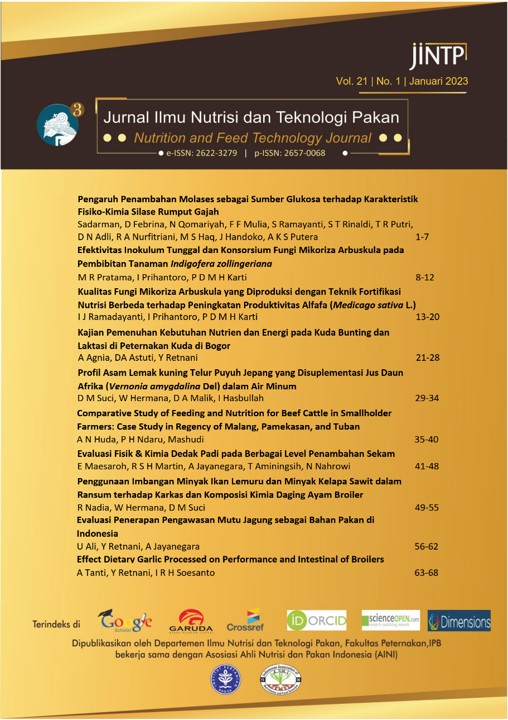Evaluasi Fisik dan Kimia Dedak Padi pada Berbagai Level Penambahan Sekam
Physical and Chemical Evaluation of Rice Bran with Various Level of Husk Addition
Abstract
The aim of this research was to analyze the physical and chemical properties of rice bran with husk addition. The percentage of husk addition was 0%, 10%, 20%, 30%, 40%, 50%, 60%, 70%, 80%, 90% and 100%. Husks were grounded and mixed with rice bran homogeneously. The mixture was analyzed for physical properties, proximate analysis and van Soest analysis. The variables in this study included visualization of husk addition in rice bran, specific gravity (SG), bulk density (BD), moisture content (MC), ash, crude protein (CP), ether extract (EE), crude fiber (CF), acid detergent fiber (ADF), cellulose and lignin. Data were presented descriptively and the correlation between each variable was conducted. The results showed that there were differences in visualization in each level of husk addition in rice bran. The addition of husks in rice bran increased the ash (Δ = 11.89), CF (Δ = 22.75), ADF (Δ = 47.23), cellulose (Δ = 24.04) and lignin (Δ = 7, 40). The decrease in SG, BD, MC, CP and EE in mixing rice bran and husk were Δ = 0.62; 62.85; 3.64; 5.73 and 9.21 respectively. The correlation between the physical properties and the chemical properties showed significant correlation (p<0.01). The addition of husks to rice bran affected the physical and chemical qualities.
Key words: chemical evaluation, husk, physical evaluation, rice bran
Downloads
References
Adler E. 1977. Lignin chemistry-past, present and future. Wood Science and Technology. 11: 169-218. .doi:10.1007/BF00365615.
AOAC. 2005. Official Methods of Analysis of AOAC International. Washington (DC): Assocition of Offcial Chemits.
Bodie AR, Micciche AC, Atungulu GG, Rothrock MJ & Ricke SC. 2019. Current trends of rice milling byproducts for agricultural applications and alternative food production systems. Frontiers in Sustainable Food System volume 3: .doi:10.3389/fsufs.2019.00047.
BPS. 2022. Statistik Tanaman Pangan 2021. Jakarta (ID) : Badan Pusat Statistik Indonesia.
Ghodrat A, Yaghobfar A, Ebrahimnezhad Y, Shahryar HA & Ghorbani A. 2017. In vitro binding capacity of organic (Wheat bran and rice bran) and inorganic (perlite) sources for Mn, Zn, Cu, and Fe. Journal of Applied Animal Research. 45(1) : 1-5. doi:10.1080/09712119.2015.1124338.
Hartmann R, Kinnunen P & Illikainen M. 2018. Cellulose-mineral interactions based on the DLVO theory and their correlation with flotability. Minerals Enggineering. 122: 44-52.doi:10.1016/j.mineng.2018.03.023.
Hassan AA, Alsamaraee WH, Abbas ER, & Fenjan K. 2015. Effect of some chemical and biological treatent of rice hulls (subose) on chemical combosition and invitro digestibility. Journal of International Academic Research for Multidisciplinary. 2(12): 302–309.doi:10.13140/RG.2.2.27663.23205.
Hidayat C, Sumiati & Iskandar S. 2015. Kualitas fisik dan kimiawi dedak padi yang dijual di toko bahan pakan di sekitar wilayah Bogor. Di dalam: Prosiding Seminar Nasional Teknologi Peternakan dan Veteriner. Hlm. 669-674. Jakarta (ID) : Badan Penelitian dan Pengembangan Pertanian.
Khalil. 1999. Pengaruh kandungan air dan ukuran partikel terhadap perubahan perilaku fisik bahan pakan lokal: kerapatan tumpukan, kerapatan pemadatan tumpukan, dan berat jenis. Media Peternakan Fakultas Peternakan Institut Pertanian Bogor. 22(1):1–11.
Kumar P, Barrett DM, Delwiche MJ & Stroeve P. 2009. Methods for pretreatment of lignocellulosic biomass for efficient hydrolysis and biofuel production. Indutrial and Engineering Chemistry Research. 48(8): 3713 – 3729 .doi:10.1021/ie801542g.
Ma’ruf A, Pramudono B & Aryanti N. 2017. Lignin isolation process from rice husk by alkaline hydrogen peroxide: Lignin and silica extracted. Di dalam: AIP Conference Proceedings. Vol. 1823. Yogyakarta (ID): Universitas Islam Indonesia.
Mitra PP & Loqué D. 2014. Histochemical staining of Arabidopsis thaliana secondary cell wall elements. Journal of Visualized Experiments. 87(e51381): 1-11. doi:10.3791/51381.
Mutya H, Kustiyo A & Jayanegara A. 2022. Estimasi kandungan lignin pada dedak padi yang bercampur sekam menggunakan KKN berbasis warna citra. Di dalam: Prosiding Seminar Nasional MIPA UNIPA. Vol. 2022. hlm. 95–101. Manokwari (ID): Universitas Papua.
Nafisah A & Nahrowi N. 2021. The potential of pollard and rice bran with fractionation process as raw materials for high fiber processed food. Food Science Technology Journal. 3(1):62-75. doi:10.33512/fsj.v3i1.12225.
Partama IBG, Yadnya TGB, Bidura IGNG, Trisnadewi AAAS & Yupardhi WS. 2019. The effect of rice hull in diets on performance, antioxidant capacity and blood chemical profile of bali duck. International Journal of Poultry Science. 18(2):69–75.doi:10.3923/ijps.2019.69.75.
Ridla M, Adjie RHN, Ansor S, Jayanegara A & Martin RSH. 2023. Korelasi sifat fisik dan kandungan nutrien dedak padi correlation of physical characteristics and nutrient content of rice bran. Jurnal Peternakan. 20(1):1–8.doi:10.24014/jupet.v20i1:18374.
Ridla M, Martin RSH, Nahrowi N, Alhasanah N & Fadhilah MS. 2022. Physical properties evaluation of rice bran forgery with corn cob addition. Jurnal Ilmu Peternakan Terapan. 6(1):9–17. doi:10.25047/jipt.v6i1.3203.
Ridla M & Rosalina A. 2014. Evaluasi pemalsuan dedak padi dengan penambahan tepung kulit kacang tanah menggunakan uji fisik. Di dalam: Agustina W, Putra SA, Sitompul RF, editor. Prosiding Konferensi dan Seminar Nasional Teknologi Tepat Guna . Bandung (ID): LIPI. hlm. 266–276.
Satjaritanun P, Regalbuto JR, Regalbuto JA, Tippayawong N & Shimpalee S. 2021. Mixing optimization with inward flow configuration contra-rotating impeller, baffle-free tank. Alexandria Engineering Journal. 60(4): 3759-3779.doi:10.1016/j.aej.2021.02.045.
SNI. 2013. Standar Nasional Indonesia Dedak Padi. Jakarta (ID): Badan Standarisasi Nasional.
Van Soest PJ, Robertson JB & Lewis BA. 1991. Methods for dietary fiber, neutral detergent fiber, and nonstarch polysaccharides in relation to animal nutrition. Journal of Dairy Science. 74(10): 3585-3597 .doi:10.3168/jds.S0022-0302(91)78551-2.
Telew C, Kereh VG, Untu IM & Rembet BW. 2013. Pengayaan nilai nutritif sekam padi berbasis bioteknologi “effective microorganisms” (EM4) sebagai bahan pakan organik. Jurnal Zootek. 32(5):158–171.
Ukil MA & Alimon AR. 1998. Chemical composition of rice bran and its fractions available in Malaysia. Di dalam: The 2nd International Seminar on Tropical Animal Production. hlm. 160–164. Yogyakarta: Universitas Gadjah Mada.
Copyright (c) 2023 E Maesaroh, R S H Martin, A Jayanegara, T Aminingsih, Nahrowi Nahrowi

This work is licensed under a Creative Commons Attribution 4.0 International License.
The authors of the submitted manuscript have to understand and agree that the copyrights published are held by Jurnal Ilmu Nutrisi dan Teknologi Pakan. Copyrights includes rights in reproducing, distributing and selling every section of articles in all forms and media. The copyright transfer form is signed by the corresponding author. The author”
• Creative Commons Attribution (CC BY)
you are allowed to:
Share – copy and redistribute the material in any medium or format
Adapt – remix, transform, and build upon the material
for any purpose, even commercially.
The licensor cannot revoke these freedoms as long as you follow the license terms.
Jurnal Ilmu Nutrisi dan Teknologi Pakan (Nutrition and Feed Technology Journal)

This work is licensed under a Creative Commons Attribution 4.0 International License.












